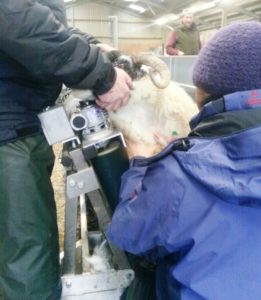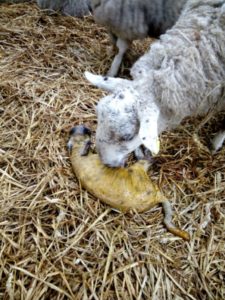Pre Lambing
Liver Fluke - Actions To Consider This Spring
In spring 2021 a number of flocks experienced ill thrift and/or deaths in ewes as a result of infection with liver fluke (Fasciola hepatica). In all cases there was a history of treatment with triclabendazole during the previous autumn and winter. Read more>>
Managing Highly Conditioned Ewes In Late Pregnancy
After an exceptionally open winter in 2021/22, ewes may be in a high order of condition. However, as pregnancy progresses, time has run out to manage these ladies to lose condition, as it can start to have a negative effect on lamb survival. Read more>>
Transitioning Off Fodder Beet
The importance of transitioning livestock on to fodder beet slowly, to allow the rumen bugs to adapt to the high sugar diet is well documented. However, as calving and lambing approaches, the slow and steady approach should also be used for transitioning the livestock off the beet. Read more>>
Start Preparations For Lambing Now
In the last six weeks of pregnancy, the lambs grow 70% of their birth weight while the ewe is also starting to make colostrum and have enough energy for maintenance. Offering tailored nutrition in the six weeks pre lambing, in the form of excellent quality ingredients is hugely important. Read more>>
Lambing Time Checklist
Successful lambing is much more than what goes on in the shed or the field at the time, planning, preparation and organisation go a long way to achieving good lamb survival. In the long term, feeding and genetics contribute the most, however as many now approach this important time of the year, attention should also start to focus on the logistics. Read more>>
Feeding Ewes In Mid Pregnancy In Snowy Conditions
For those lambing in March/April the nutritional requirements of the ewe are still fairly low compared to close up lambing, however it is vital to the development of the placenta during this period that ewes do not face prolonged nutritional stress. Research suggests a higher mortality rate following maternal under nutrition in mid-pregnancy. Read more>>
Twin Lamb Disease In Ewes That Are Fit
Fit ewes can be as susceptible to twin lamb disease (aka pregnancy toxaemia) as thin ewes although the prevention is slightly different.
Remember, twin lamb disease is a result of lack of energy to meet the demands of the growing foetus(es) and the risk period is three to four weeks pre-lambing. The rumen volume of overfat ewes may be restricted due to the excess fat in the abdomen taking up space. Read more>>
Pre-Lambing Metabolic Profiling
Blood testing ewes 3 – 4 weeks before lambing is a great way to assess how the ration being offered is feeding. It gives you the knowledge if what is being fed is sufficient and if not what adjustments can be made. Ideally you want to sample at least five ewes from each management group (triplets, twins and singles). Read more>>
Investigating Sheep Abortions
Lambing is underway for many pedigree flocks and will be due to start soon for lots of others. As such, SRUC Veterinary services are starting to see sheep abortions coming into the lab. Abortion investigations can help to reduce the incidence this year and hopefully help to prevent abortions next year. Read more>>
Managing Ewes In Mid Pregnancy
After around 50 days from tup introduction with the ewes, the ewes enter a relatively resilient phase – mid pregnancy. The embryo should be implanted, and their nutritional demand is low compared with late- pregnancy. Read more>>
Preparation For Lambing
Being prepared for lambing by means of management and feeding is the first step to a successful lambing. The aim is to have lambs with high vigour – getting up on their feet and sucking quickly, having the ewe in the correct condition to avoid lambing difficulties, metabolic disorders and have a good supply of quality colostrum and milk for the lambs. By six weeks pre lambing the foetus will have only grown 25% of the final weight, leaving a huge 75% of foetal growth for the last six weeks of pregnancy. Read more>>
Overfat Ewes
We are seeing a lot of fat ewes again this winter. Although this is better than lean ewes, it leads us to worry about the implications for prolapses this lambing season.
What can you do now if ewes are overfat Read more>>
Winter Housing and Shearing of Ewes
Many now choose to house ewes post-Christmas, this is to prevent damage to the grass sward through, poaching during the winter. As well as allowing a 90 day rest period for the grass prior to lambing. Housed ewes typically have a full fleece, which is designed to insulate the sheep during winter. As well an insulation, wool can absorb and release moisture and is a natural regulator, helping the sheep to maintain a stable temperature. However, in mild conditions is there an opportunity to shear ewes at housing? Read more>>
High Quality Silage Feeding For Ewes
It is well established that making very good quality silage (11 ME+) reduces costs in feeding pregnant ewes coming up to lambing for those who are lambing indoors. This will not be possible to do in all systems, but where it can be done there are considerable cost savings in concentrates. The reason it works so well is that high quality silages provide more energy per bite and due to improved digestibility, the ewe’s intakes of very good quality silages are much higher than poorer silages. The intake of silage also depends on how it is presented to the sheep. Read more>>
Avoiding Listeriosis
Feed the best quality silage you can to the most sensitive stock particularly pregnant sheep and cattle. Discard and do not feed silage that is visibly mouldy. Dilute high risk forages with good forage, if this is not possible seek advice on alternative options for feeds. Read more>>
What Causes Lamb Deaths On Your Farm?
Recording lamb death is not a fun activity but it can be useful to identify patterns early on and refine management for next year. A simple tally can be downloaded here and placed near the dead lamb disposal area on a clipboard for all staff to complete. Read more>>
Detecting Ewe Under Nutrition In Late Pregnancy
70% of foetal growth occurs in the last 6 weeks of gestation making it crucial to avoid ewe undernutrition during this time. BOHB is found in high levels in the blood of undernourished sheep, and so blood sampling to measure it can detect whether feeding is meeting the increased energy demands of pregnancy, while there is still time to adjust the diet. Cases of pregnancy toxaemia are a clear indication of a problem, but are only the tip of the iceberg. Read more>>
Correcting BOHD Levels
A useful check for diet adequacy is a blood sample for the concentration of the ketone β- hydroxyl butyrate (BOHB). This is produced when the reserves of the ewe are mobilised. Monitoring the BOHB level pre-lambing is a good way of checking that the ewe is not in serious energy deficit. Read more>>
Nutritional Influencers of Lamb Birthweight
Mid- and late-pregnancy management does influence lamb birth weight; mid-pregnancy due to placenta development and late-pregnancy due to foetal growth. Read more>>
Don't Forget About ERDP
Some producers short of forage are turning to straw and old (often poor) hay to fill the gap. In these situations it can be easy to think the supply of the energy on offer will be enough in the early stages of pregnancy when the requirement is still fairly low. However, it’s important not to overlook protein requirement. Read more>>
Sign up to the FAS newsletter
Receive updates on news, events and publications from Scotland’s Farm Advisory Service

















